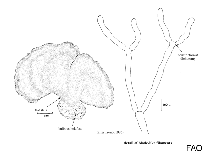Tydemania expeditionis Weber-van Bosse
Green sea beads| Native range | All suitable habitat | Point map | Year 2050 |

|
| This map was computer-generated and has not yet been reviewed. |
| Tydemania expeditionis AquaMaps Data sources: GBIF OBIS |
Upload your photos
Google image | No image available for this species;
drawing shows typical species in Udoteaceae.
Google image | No image available for this species;
drawing shows typical species in Udoteaceae.
Classification / Names Common names | Synonyms | CoL | ITIS | WoRMS
Bryopsidophyceae | Bryopsidales | Udoteaceae
Environment: milieu / climate zone / depth range / distribution range Ecology
Sessile; depth range 0 - 50 m (Ref. 102147). Tropical
Distribution Countries | FAO areas | Ecosystems | Occurrences | Introductions
Indian Ocean: in Tanzania, Amirante Islands and Seychelles, east to India including Maldives and Chagos Archipelago; in Andaman and Nicobar Islands; Pacific Ocean: from China to the South China Sea, south to Queensland, Australia, including Spermonde Archipelago, Guam, Federated States of Micronesia, Marshall Islands, Solomon Islands, Fiji, and Lord Howe Island, east to American Samoa.
Length at first maturity / Size / Weight / Age
Maturity: Lm ? range ? - ? cm
Short description Morphology
Thallus green, slightly calcified, forming thick clumps on sandy-rocky substrate in subtidal areas. Main branches terete, with successive whorls of glomeruliferous branches along the entire length at intervals of about 1 cm. Each whorl composed of 4 or 5 verticillately arranged lateral branchlets which are dichotomously branched repeatedly (6 to 7 times) in alternate planes, rarely trichotomously branched. Thallus up to 10 cm in height (Ref. 80758).
Contains norcycloartene triterpenoids (Ref. 80758).
Life cycle and mating behavior Maturity | Reproduction | Spawning | Eggs | Fecundity | Larvae
Main reference
References | Coordinator | Collaborators
Guiry, M.D. and G.M. Guiry. 2009. (Ref. 80701)
IUCN Red List Status (Ref. 130435: Version 2024-1)
CITES status (Ref. 108899)
Not Evaluated
CMS (Ref. 116361)
Not Evaluated
Threat to humans
Human uses
| FishSource |
Tools
More information
Trophic Ecology
Food items
Diet
Food consumption
Ration
Predators
Diet
Food consumption
Ration
Predators
Ecology
Population dynamics
Growth
Age/Size
Length-weight
Length-length
Length-frequencies
Mass conversion
Recruitment
Abundance
Age/Size
Length-weight
Length-length
Length-frequencies
Mass conversion
Recruitment
Abundance
Life cycle
Reproduction
Maturity
Fecundity
Spawning
Eggs
Egg development
Larvae
Larval dynamics
Maturity
Fecundity
Spawning
Eggs
Egg development
Larvae
Larval dynamics
Distribution
Human Related
Aquaculture profile
Stamps, Coins Misc.
Stamps, Coins Misc.
Outreach
References
Internet sources
BHL | BOLD Systems | CISTI | DiscoverLife | FAO(Publication : search) | Fishipedia | GenBank (genome, nucleotide) | GloBI | Gomexsi | Google Books | Google Scholar | Google | PubMed | AlgaeBase | Tree of Life | Wikipedia (Go, Search) | Zoological Record
Estimates based on models
Preferred temperature
(Ref. 115969): 24.7 - 29, mean 27.9 (based on 808 cells).



